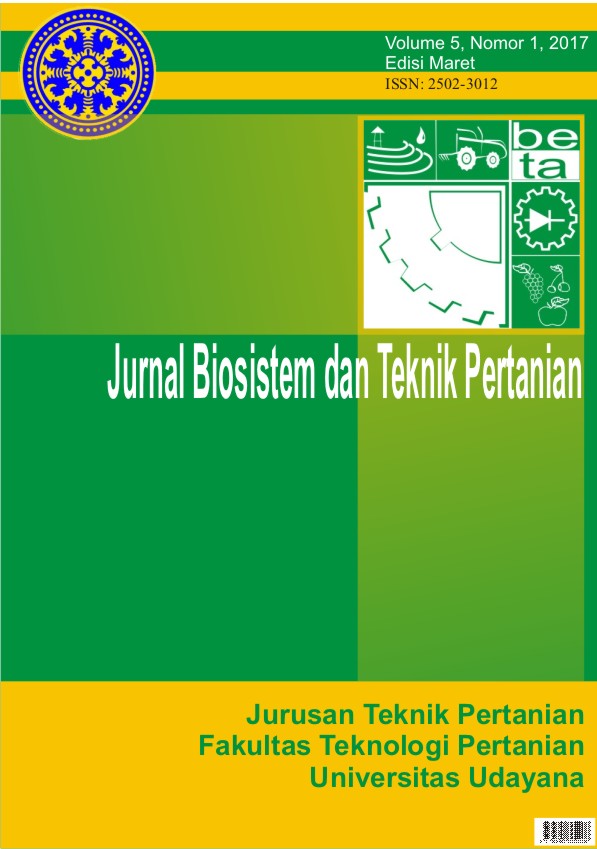Pengaruh Sistem Manajemen Keamanan Pangan ISO 22000:2005 Terhadap Kinerja Perusahaan
Abstract
Industri pangan yang beroperasi di pasar global harus memiliki sistem manajemen keamanan dan mutu pangan yang berstandar internasional. Tujuan penelitian ini adalah untuk mengetahui tingkat kepuasan karyawan dalam penerapan sistem manajemen keamanan dan mutu pangan ISO 22000:2005 terhadap kinerja perusahaan PT. Aerofood ACS Denpasar. Penerapan sistem ISO 22000:2005 diukur atas dasar empat elemen kunci yaitu penerapan program persyaratan kelayakan dasar, prinsip HACCP, komunikasi interaktif dan penerapan sistem manajemen sumberdaya. Sedangkan kinerja perusahaan diukur dengan metode Balanced Scorecard. Hasil penelitian menunjukkan bahwa 88,56% karyawan puas terhadap penerapan sistem ISO 22000:2005 dan 81,93% puas terhadap kinerja perusahaan. Penerapan sistem ISO 22000:2005 berpengaruh positif dan signifikan terhadap kinerja perusahaan. Dari keempat elemen kunci tersebut ditemukan bahwa penerapan program persyaratan kelayakan dasar berkontribusi paling tinggi terhadap peningkatan kinerja dalam hal keuangan, kepuasan pelanggan, proses bisnis internal dan kinerja dari perspektif pembelajaran dan pertumbuhan. Sebelum penerapan sistem ISO 22000:2005, PT. Aerofood ACS Denpasar hanya melayani sebanyak 7 maskapai penerbangan, akan tetapi setelah sukses menerapkan sistem tersebut, terjadi peningkatan jumlah pelanggan yang drastis yaitu sebanyak 23 maskapai penerbangan.
Food industries operating in the global market must have a safety management system and international quality standards of food. The aimed of this research was to determine the level of employee satisfaction in the implementation of safety management system and food quality ISO 22000: 2005 towards the performance of PT. Aerofood ACS Denpasar. The implementation of ISO 22000: 2005 was determined using the basic of four key elements, namely the prerequisite programs, HACCP principles, interactive of communication and implementation of resource management system. Meanwhile, the company's performance was determined by the method of Balanced Scorecard. The results showed that 88.56% of employees were satisfied by the implementation of ISO 22000: 2005 and 81.93% were satisfied by the performance of the company. The implementation of ISO 22000:2005 gives positive and significant effect towards company performance. Among the four key elements of the program that were used, it was found that the prerequisite program had the highest impact to improve the performances in terms of financial, customer satisfaction, internal business processes and performance from the perspective of learning and growth. Before PT. Aerofood ACS Denpasar implemented ISO 22000: 2005, it only had cooperation with 7 airlines, but after the success of ISO’s implementation, the number of customers has significantly increased to be 23 airlines.
Downloads
References
Dessler, G. 2000. Human Resource Management, Seventh edition, by Prentice Hall, Inc, New Jersey. Diakses tanggal: 20 Mei 2016.
Færgemand, J. and Jespersen., D. 2004. ISO 22000 to ensure integrity of food supply chain. www.iso.org/iso/tool_5-04.pdf.Diakses tanggal: 4 Juni 2016.
FAO/WHO. 1997. Codex Alimentarius Guidelines for the Design, Operation, Assessment and Accreditation of Food Import and Export Inspection and Certification Systems (CAC/GL 26-1997). FAO/WHO, Rome. Webster’s Ninth New Collage Dictionary. http://www.merriamwebster.com/dictionary/safety. Diakses tgl: 24 Juni 2016.
Hatim, A., Suliman, S. and Abdalla, M. 2013. Implementation of HACCP and food safety program in Al-Ain City Abu Dabi. Journal of Food, Nutritional Disorders, Vol. 2 No. 3, p. 3. Diakses tanggal: 7 Agustus 2016.
Herath, D. and Henson, S. 2010. Barriers to HACCP implementation: evidence from the food processing sector in Ontario Canada Agribusiness, Vol. 26 No. 2, pp. 265-279. Diakses tanggal: 10 Agustus 2016.
Hielm, S., Tuominen, P., Aarnisalo, K., Raaska, L. and Maijala, R. 2006. Attitudes Towards Ownchecking and HACCP Plans Among Finnish Food Industry Employees, Food Control, Vol. 17 No. 5, pp. 402-407. Diakses tanggal: 10 Agustus 2016.
Junaidi. 2014. Menghitung Nilai Distribusi F, Distribusi t dan Distribusi r dengan Microsoft Excel. Fakultas Ekonomi dan Bisnis. Universitas Jambi. Jambi.
Juwita, Cecilia. 2013. Delapan Prinsip Manajemen Mutu ISO. Premysis Consulting. http://www.premysisconsulting.com/2013/09/19/8-prinsip manajemen-mutu-iso-9001/. Diakses tanggal: 20 Mei 2016.
Kaplan, R.S. and Norton, D.P. 1996. Balanced Scorecard Translating Strategy Into Action. Harvard Business School Press. Boston. Penerjemah Pasla, Y. dan Sumiharti, Y. 2000. Erlangga. Jakarta.
Nugroho W.A. 2013. Analisis Pengukuran Kinerja Perusahaan dengan Konsep Balanced Scorecard (Studi Kasus PT. Wijaya Karya). Fakultas Ekonomi dan Bisnis. Universitas Islam Negeri Syarif Hidayatullah. Jakarta.
Prasetyo. 2010. Metode Penelitian Kuantitatif Teori dan Aplikasi. Raja Wali Press. Jakarta.
Samuel, H. dan Zulkarnain. 2011. Sistem Manajemen Mutu ISO terhadap Kinerja Karyawan Melalui Budaya Kualitas Perusahaan (Studi Kasus PT. Otsuka Indonesia Malang). Universitas Kristen Petra. Surabaya.
Seward, S. 2000. Application of HACCP in food service, Irish Journal of Agricultural and Food Research. Vol. 39 No. 2, pp. 221-227. Diakses tanggal: 7 Agustus 2016.
Sugiyono. 2012. Metode Penelitian Kuantitatif Kualitatif dan R&B. Alfabeta. Bandung.
Sun, Y.M. and Ockerman, H.W. 2005. A review of the needs and current applications of hazard analysis and critical control point (HACCP) system in foodservice areas, Food Control, Vol. 16 No. 4, pp. 325-332. Diakses tanggal: 7 Agustus 2016.
Tavakkoli, H., Zabihi, A., Khatibi, S. A., Nasiri, T., Kaviani, L., & Dopeykar, N. 2015. Status of prerequisite programs for the implementation of HACCP system in chain restaurants in iran. British Food Journal, 117(6), 1753-1763. http://search.proquest.com/Diakses tanggal: 26 Juni 2016.
Tjiptono, F.dan A. Diana. 2003. Total Quality Management Edisi Revisi. Yogyakarta.
Wahyuni, Sri. 2011. Analisis Balanced Scorecard Sebagai Alat Pengukuran Kinerja pada PT. Semen Bosowa Maros. Jurusan Akuntansi, Fakultas Ekonomi, Universitas Hasanuddin. Makassar.
Wallace, C. and Williams, T. 2001. Pre-requisites a help or a hindrance to HACCP Food Control. Vol. 12 No. 4, pp. 235-240. Diakses tanggal: 7 Agustus 2016.
Wicaksono, Setiawan. 2006. Pengaruh Implementasi Total Quality Management (TQM) terhadap Budaya Kualitas (Studi pada PT. Hari Terang Industri Surabaya). Universitas Brawijaya. Malang.












 Jurnal BETA (Biosistem dan Teknik Pertanian)
Jurnal BETA (Biosistem dan Teknik Pertanian)


